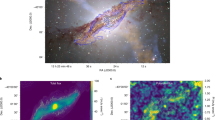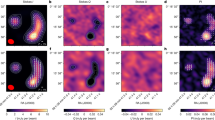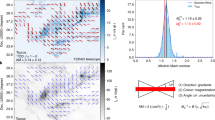Abstract
Magnetic fields in accretion disks play a dominant part during the star formation process1,2 but have hitherto been observationally poorly constrained. Field strengths have been inferred on T Tauri stars3 and possibly in the innermost part of their accretion disks4, but the strength and morphology of the field in the bulk of a disk have not been observed. Spatially unresolved measurements of polarized emission (arising from elongated dust grains aligned perpendicularly to the field5) imply average fields aligned with the disks6,7. Theoretically, the fields are expected to be largely toroidal, poloidal or a mixture of the two1,2,8,9,10, which imply different mechanisms for transporting angular momentum in the disks of actively accreting young stars such as HL Tau (ref. 11). Here we report resolved measurements of the polarized 1.25-millimetre continuum emission from the disk of HL Tau. The magnetic field on a scale of 80 astronomical units is coincident with the major axis (about 210 astronomical units long12) of the disk. From this we conclude that the magnetic field inside the disk at this scale cannot be dominated by a vertical component, though a purely toroidal field also does not fit the data well. The unexpected morphology suggests that the role of the magnetic field in the accretion of a T Tauri star is more complex than our current theoretical understanding.
This is a preview of subscription content, access via your institution
Access options
Subscribe to this journal
Receive 51 print issues and online access
$199.00 per year
only $3.90 per issue
Buy this article
- Purchase on Springer Link
- Instant access to full article PDF
Prices may be subject to local taxes which are calculated during checkout


Similar content being viewed by others
References
Blandford, R. D. & Payne, D. G. Hydromagnetic flows from accretion discs and the production of radio jets. Mon. Not. R. Astron. Soc. 199, 883–903 (1982)
Balbus, S. A. & Hawley, J. F. Instability, turbulence, and enhanced transport in accretion disks. Rev. Mod. Phys. 70, 1–53 (1998)
Johns-Krull, C. M. The magnetic fields of classical T Tauri stars. Astrophys. J. 664, 975–985 (2007)
Donati, J.-F., Paletou, F., Bouvier, J. & Ferreira, J. Direct detection of a magnetic field in the innermost regions of an accretion disk. Nature 438, 466–469 (2005)
Lazarian, A. Tracing magnetic fields with aligned grains. J. Quant. Spectrosc. Radiat. Transf. 106, 225–256 (2007)
Tamura, M., Hough, J. H. & Hayashi, S. S. 1 millimeter polarimetry of young stellar objects: low-mass protostars and T Tauri stars. Astrophys. J. 448, 346–355 (1995)
Tamura, M. et al. First detection of submillimeter polarization from T Tauri stars. Astrophys. J. 525, 832–836 (1999)
Cho, J. & Lazarian, A. Grain alignment and polarized emission from magnetized T Tauri disks. Astrophys. J. 669, 1085–1097 (2007)
Königl, A. & Pudritz, R. E. in Protostars and Planets IV (eds Mannings, V., Boss, A. P. & Russell, S. S. ) 759–787 (Univ. Arizona Press, 2000)
Hennebelle, P. & Ciardi, A. Disk formation during collapse of magnetized protostellar cores. Astron. Astrophys. 506, L29–L32 (2009)
Robitaille, T. P., Whitney, B. A., Indebetouw, R. & Wood, K. Interpreting spectral energy distributions from young stellar objects. II. Fitting observed SEDs using a large grid of precomputed models. Astrophys. J. Suppl. Ser. 169, 328–352 (2007)
Kwon, W., Looney, L. W. & Mundy, L. G. Resolving the circumstellar disk of HL Tauri at millimeter wavelengths. Astrophys. J. 741, 3 (2011)
Rebull, L. M., Wolff, S. C. & Strom, S. E. Stellar rotation in young clusters: the first 4 million years. Astron. J. 127, 1029–1051 (2004)
Movsessian, T. A., Magakian, T. Y. & Moiseev, A. V. Kinematics and the origin of the internal structures in HL Tauri jet (HH 151). Astron. Astrophys. 541, A16 (2012)
Welch, W. J., Hartmann, L., Helfer, T. & Briceño, C. High-resolution, wide-field imaging of the HL Tauri environment in 13CO (1–0). Astrophys. J. 540, 362–371 (2000)
Greaves, J. S., Richards, A. M. S., Rice, W. K. M. & Muxlow, T. W. B. Enhanced dust emission in the HL Tau disc: a low-mass companion in formation? Mon. Not. R. Astron. Soc. 391, L74–L78 (2008)
Hughes, A. M. et al. A spatially resolved inner hole in the disk around GM Aurigae. Astrophys. J. 698, 131–142 (2009)
Hughes, A. M., Hull, C. L. H., Wilner, D. J. & Plambeck, R. L. Interferometric upper limits on millimeter polarization of the disks around DG Tau, GM Aur, and MWC 480. Astron. J. 145, 115 (2013)
Rao, R., Girart, J. M., Lai, S.-P. & Marrone, D. P. Detection of a magnetized disk around a very young protostar. Astrophys. J. 780, L6 (2014)
Loinard, L. et al. ALMA and VLA observations of the outflows in IRAS 16293–2422. Mon. Not. R. Astron. Soc. 430, L10–L14 (2013)
Lay, O. P., Carlstrom, J. E. & Hills, R. E. Constraints on the HL Tauri protostellar disk from millimeter- and submillimeter-wave interferometry. Astrophys. J. 489, 917–927 (1997)
Girart, J. M., Rao, R. & Marrone, D. P. Magnetic fields in the formation of sun-like stars. Science 313, 812–814 (2006)
Stephens, I. W. et al. The magnetic field morphology of the class 0 protostar L1157-mm. Astrophys. J. 769, L15 (2013)
Hull, C. L. H. et al. Misalignment of magnetic fields and outflows in protostellar cores. Astrophys. J. 768, 159 (2013)
Hull, C. L. H. et al. TADPOL: A 1.3 mm survey of dust polarization in star-forming cores and regions. Astrophys. J. Suppl. Ser. 213, 13 (2014)
Evans, N. J., II et al. The Spitzer c2d legacy results: star-formation rates and efficiencies; evolution and lifetimes. Astrophys. J. Suppl. Ser. 181, 321–350 (2009)
Wardle, M. & Koenigl, A. The structure of protostellar accretion disks and the origin of bipolar flows. Astrophys. J. 410, 218–238 (1993)
Sault, R. J., Teuben, P. J. & Wright, M. C. H. in Astronomical Data Analysis Software and Systems IV (eds Shaw, R. A., Payne, H. E. & Hayes, J. J. E. ) 433–436 (Astron. Soc. Pacif. Conf. Ser. Vol. 77, 1995)
Witzel, A., Heeschen, D. S., Schalinski, C. & Krichbaum, T. Kurzzeit-Variabilität extragalak-tischer Radioquellen. Mitt. Astron. Ges. Hamburg 65, 239 (1986)
Tafoya, D., Gómez, Y. & Rodríguez, L. F. Imaging MWC 349 from 7 millimeters to 90 centimeters. Astrophys. J. 610, 827–834 (2004)
Marrone, D. P. & Rao, R. The submillimeter array polarimeter. Proc. SPIE 7020, 70202B (2008)
Dullemond, C. P. & Dominik, C. Flaring vs. self-shadowed disks: the SEDs of Herbig Ae/Be stars. Astron. Astrophys. 417, 159–168 (2004)
Acknowledgements
We thank R. L. Plambeck and C. L. H. Hull for consultation during the data reduction process and C. F. Gammie for discussions. This research made use of APLpy, an open-source plotting package for Python hosted at http://aplpy.github.com. Work at the Universities of Illinois and Maryland was supported by NSF AST-1139950 and AST-1139998, respectively. Support for CARMA construction was derived from the states of California, Illinois and Maryland, the James S. McDonnell Foundation, the Gordon and Betty Moore Foundation, the Kenneth T. and Eileen L. Norris Foundation, the University of Chicago, the Associates of the California Institute of Technology, and the National Science Foundation. Ongoing CARMA development and operations are supported under a cooperative agreement (NSF AST 08-38226) and by the CARMA partner universities.
Author information
Authors and Affiliations
Contributions
Data acquisition and reduction were performed by I.W.S., L.W.L. and M.F.-L. Polarization modelling was performed by W.K. and fitted by I.W.S. All authors analysed and discussed the observations and manuscript.
Corresponding author
Ethics declarations
Competing interests
The authors declare no competing financial interests.
PowerPoint slides
Rights and permissions
About this article
Cite this article
Stephens, I., Looney, L., Kwon, W. et al. Spatially resolved magnetic field structure in the disk of a T Tauri star. Nature 514, 597–599 (2014). https://doi.org/10.1038/nature13850
Received:
Accepted:
Published:
Issue Date:
DOI: https://doi.org/10.1038/nature13850
This article is cited by
-
Aligned grains and scattered light found in gaps of planet-forming disk
Nature (2023)
-
Self-similar energetics in large clusters of galaxies
Nature (2015)
-
Disks and Jets
Space Science Reviews (2015)
-
Secret ingredient exposed
Nature (2014)
Comments
By submitting a comment you agree to abide by our Terms and Community Guidelines. If you find something abusive or that does not comply with our terms or guidelines please flag it as inappropriate.



